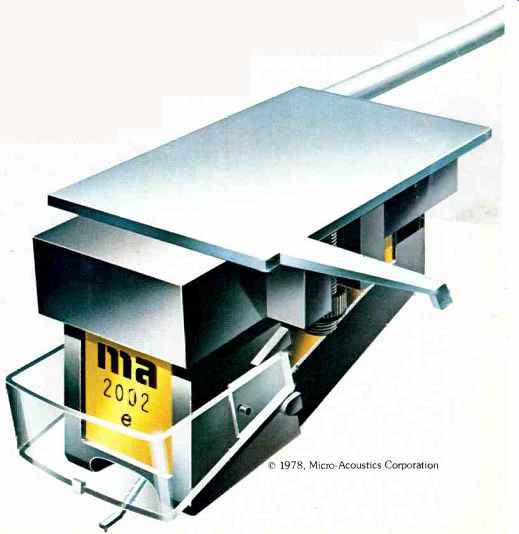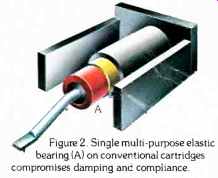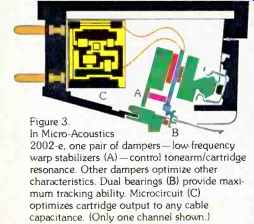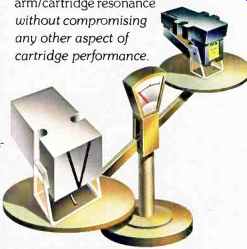How to improve your tonearm.

One of the most frequently asked questions in high fidelity these days is how well a particular tonearm and cartridge work together. Because tonearm/cartridge compatibility is increasingly recognized as vital to accurate record reproduction.
At Micro-Acoustics, we have a unique solution: the first phono cartridge specifically designed to help any tonearm work at its best--whether that tonearm is straight or S-shaped, low- or high-mass, with low to high cable capacity. We call it the 2002-e ... and it offers significant advantages over conventional cartridge designs.
Tonearm/cartridge resonance: a critical problem Record warp, present to some degree on nearly every disc you play, causes the cartridge to move up and down about the stylus (see Figure 1). This low-frequency up-and-down oscillation-called tonearm/cartridge resonance--can be considerable, since the amplitude of record warp can actually be twelve to fifty times that of the loudest musical program material.
During the upward motion of the tonearm/cartridge combination, the stylus tends to be pulled out of the groove, reducing tracking force to a fraction of the tonearm setting.
When this lower tracking force coincides with a loud musical passage, the cartridge mistracks, causing audible distortion and sometimes, groove jumping.
There is a common misconception that tonearm/cartridge resonance can be "matched" out of existence.
The fact is, it cannot: it must be controlled to allow the cartridge to function properly.
Compromised vs. optimized damping
The most important factor in controlling this tonearm/ cartridge oscillation is damping-a mechanical counterforce precisely applied to suppress resonance.
Because the tonearm must be absolutely free to move, virtually all tone arms are totally undamped devices.
So damping must be supplied by the cartridge.
In conventional cartridges, damping of tonearm/cartridge resonance must be a compromise.
Because it is provided by a single, multi-purpose elastic bearing (see Figure 2) which must trade off maximum compliance for tracking ability (less damping) with maximum suppression of high-frequency stylus resonance and tonearm/ cartridge low-frequency resonance (more damping). In contrast to this, Micro-Acoustics' 2002-e (Figure 3) has a sophisticated multiple damping system utilizing eight specialized dampers. One pair of these dampers are low-frequency warp stabilizers, specifically designed to control tonearm/cartridge resonance.
This is the first effective warp-control system because it suppresses oscillation at the cantilever pivot, where it occurs-rather than using an external device that rides ahead of the stylus.
The remaining six dampers are optimized for stylus high-frequency damping and other factors, while our exclusive dual-bearing system independently optimizes tracking ability.
By designing separate systems for damping and compliance within the 2002-e, we can precisely control tonearm/cartridge resonance without compromising any other aspect of cartridge performance.

Figure 1. Record warp activates tonearm/cartridge resonance, undesirably
reducing and increasing stylus force. (A) Normal position--normal tracking
force.(B) Compressed position--increased tracking force.(C) Extended position-decreased
tracking force. Record direction is right to left.

Figure 2. Single multi-purpose elastic bearing (A) on conventional cartridges
compromises damping and compliance.

Figure 3. In Micro-Acoustics B 2002-e, one pair of dampers-low-frequency
warp stabilizers (A) control tonearm/cartridge resonance. Other dampers optimize
other characteristics. Dual bearings (B) provide maximum tracking ability.
Microcircuit (C) optimizes cartridge output to any cable capacitance. (Only
one channel shown.)

Figure 4. 2002-e is less than half the weight of many other quality cartridges.
High vs. low cartridge body weight.

Figure 5. With conventional cartridges (A), low cable capacity causes response
to peak; medium-to-high capacity (B) causes high-frequency response to roll
off. Response of 2002-e (C) is unaffected.
Regardless of the tonearm and damping system utilized, the lower the cartridge body weight, the greater the tonearm's ability to track warped records. This is because lower tonearm/cartridge weight allows damping to more effectively counteract tonearm/cartridge resonance.
At four grams, the Micro Acoustics 2002-e is half the weight of many other high-quality cartridges, yielding two or more times the effective damping (see Figure 4).
Cable capacitance capability
Another important limitation of conventional cartridges is their interaction with cable capacity, which causes a deterioration in high-frequency response and transient ability (see Figure 5). In contrast to this, the 2002-e has a passive microcircuit which automatically matches the cartridge output to any tonearm's cable capacity, providing linear high frequency response and transient accuracy.
Tonearm optimization made easy
If there were no such thing as tonearm/cartridge resonance or cable capacity, any cartridge would match any tonearm. But in the real world, where these problems exist, the only way to get optimum performance from your tonearm is the Micro Acoustics 2002-e. Or our other direct-coupled cartridges: the moderately-priced 282-e and top-of –the-line 530-mp. All of them offer advantages you can hear today, at your Micro-Acoustics dealer.
Micro-Acoustics Corporation, 8 Westchester Plaza, Elmsford, NY 10523. 914-592-7627.
In Canada H. Roy Gray Ltd., Markham, Ont.
ma -- Micro-Acoustics Because good tracking isn't enough.
(Source: Audio magazine, Sept. 1978)
= = = =